As a classic tourist destination in Germany with so much to offer, travelers get a lot out of a trip to Munich. Despite its smaller size, Munich rivals Berlin for the country’s most popular destination. Yes, Munich is home to Oktoberfest, but there’s much more to Munich than the one festival, which is why it’s remained an essential stop when visiting Germany.
Even with such a well-known destination, it always helps to have a clear idea of what you want to do on a visit. Which is what this Munich itinerary is for. You’ll learn about all the best places to visit in Munich to ensure you don’t miss out on any great attractions. So, let’s dive right in so you can begin planning your three days in Munich.
Best Time to Visit Munich
To really enjoy your time in the city, it’s crucial that you fully appreciate what it’s like at different times of the year. Not only does Munich experience four distinct seasons, it also has a jam-packed tourist calendar thanks to local festivals. Choosing the right time to visit is really going to depend on what you hope to get out of your trip.
If all you want to do is see and experience the city without too much hassle, the best time to visit Munich is from March to May. The weather is quite pleasant at this time, and there are fewer tourists around. The weather can also be quite nice during summer and autumn, but both seasons fall under Munich’s high season. So if you’re looking for fewer crowds and better rates on hotel rooms, spring is the time to go.
While summer is busy because of the usual summer surge in Europe, autumn is busy because of the Oktoberfest, which runs from September to early October, making it the busiest and most expensive time to visit. Even coming for the Christmas markets in December is comparatively quiet.
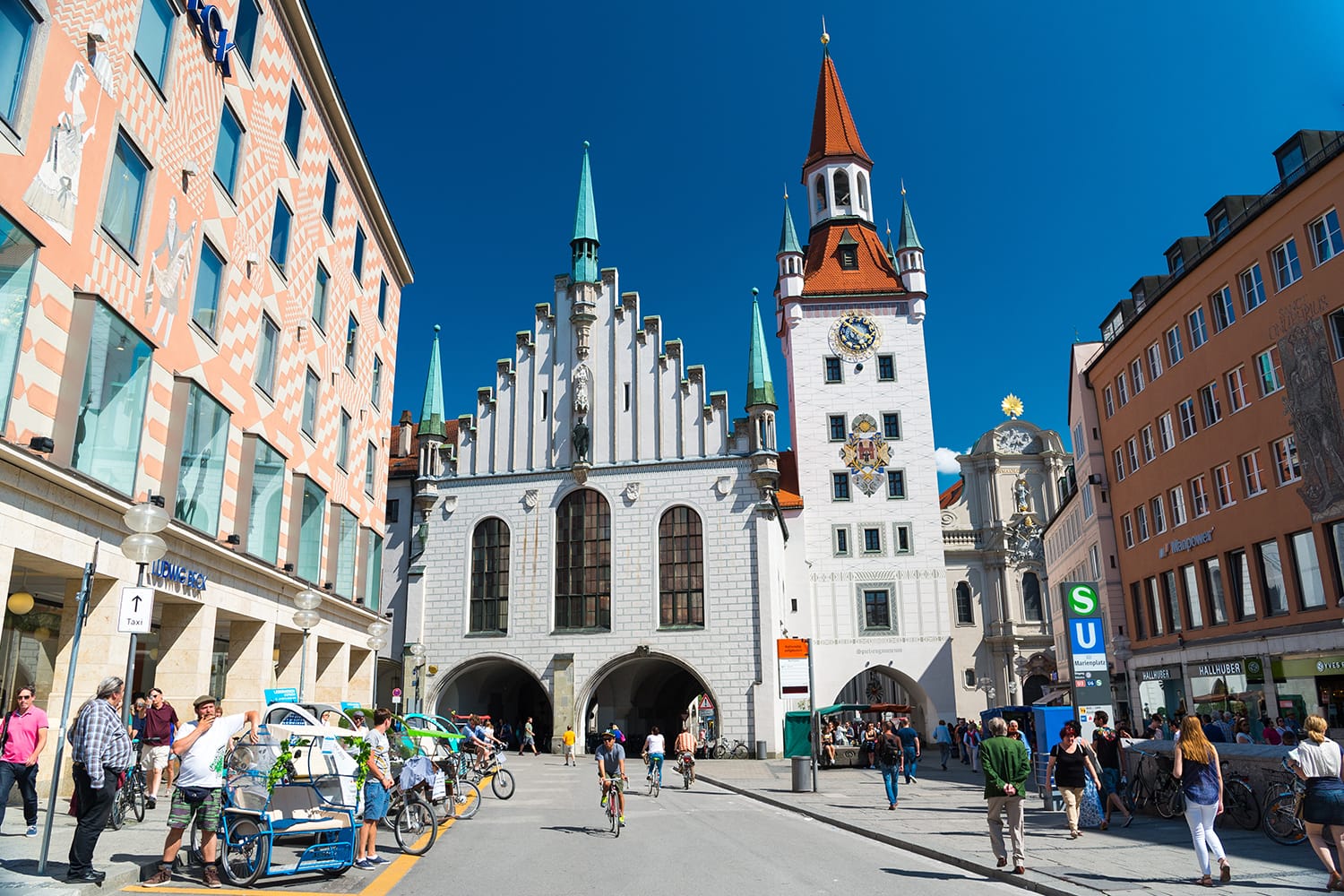
How to Get Around Munich
While visiting Munich, you’re going to be exploring various corners of the city, which means it’s important to understand the best ways to get around. While in the city’s Old Town, you shouldn’t have much trouble getting around on foot. However, to really get the most out of your visit and see places that are beyond walking distance, you need to know the available public transport options.
Being a major German city, Munich enjoys a comprehensive public transport network made up of an underground metro (U-Bahn), suburban trains (S-Bahn), trams, and buses. Trams and the U-Bahn should get you most places you need to go. All networks use the same tickets, which can be bought from blue vending machines at metro stations and some bus and tram stops. The basic type of ticket is the €2.30 single trip ticket, but there are various other types of tickets available.
Recommendation: Another great way to get around for tourists is on a hop-on hop-off bus. You’ll get to enjoy magnificent views of the city, from Olympic Park to Nymphenburg Palace, and be able to get on or off the bus anytime you like to experience the city at your own pace. You can buy your hop-on hop-off bus tickets here.
If you’re flying into Munich International Airport, the best way to get into the city center is by train or bus. Trains run from the airport to the city center every 10 minutes and take around 35 minutes. Alternatively, hop aboard the Lufthansa Express Bus, which takes 45 minutes and runs every 15 minutes. The bus can be used by all travelers, not just Lufthansa passengers.
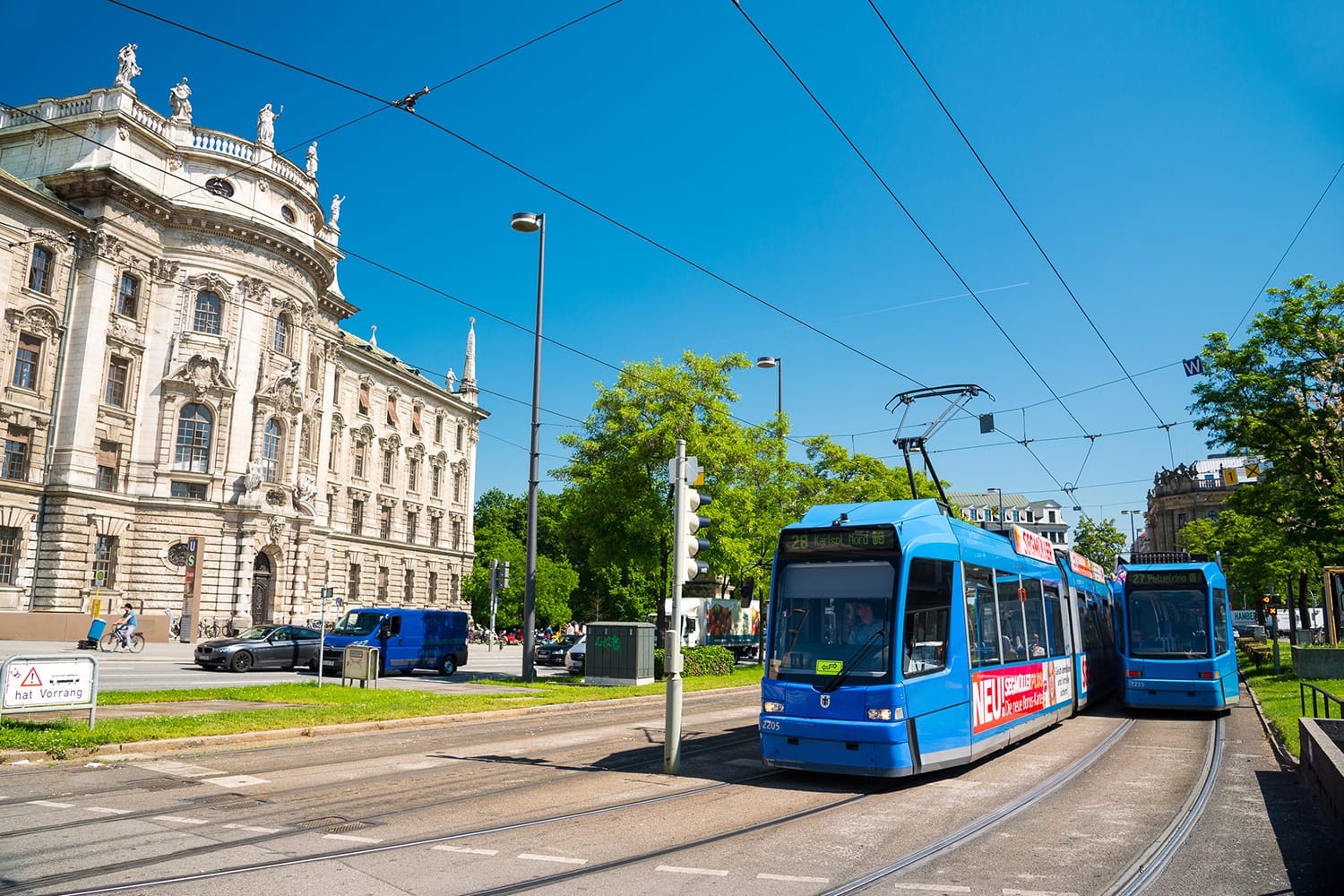
Where to Stay in Munich
Figuring out where to stay is often the most stressful step of planning a trip, especially when you’re going to be somewhere for several nights. Thankfully, because Munich is such a well-known tourist destination, you’ll have plenty of places to choose from. Leave it too late, though, and you might miss out on the best places to stay in Munich.
A major part of deciding where to stay in Munich is understanding the layout of the city. You naturally want to be close to the city’s sights, restaurants, and beer gardens, but that often comes at a price. Ideally, you want somewhere in the city’s Old Town, but the nearby neighborhood of Ludwigsvorstadt is another common choice for more reasonably priced accommodation.
To treat yourself during your stay in Munich, choose the incredible Bayerischer Hof as your base. This superb five-star hotel is situated inside a historic building while still providing guests every modern convenience, including five restaurants, six bars, and a rooftop pool and spa.
For a comfortable stay that’s still reasonably priced, look no further than the Mercure München City Center. Ideally located between the city center and the main train station, the rooms in this four-star hotel have a modern design with Bavarian influences.
You can also look at Airbnb for affordable accommodation in Munich. For recommendations, check out our list of the best Airbnbs in Munich.
Munich isn’t a city that’s known for being budget-friendly, but a great cheap option is the Euro Youth Hostel Munich. This hostel has clean and spacious dorms and private rooms, and is located in a convenient yet quiet part of the city. For other hostel recommendations, take a look at our guide to the best hostels in Munich.
For more accommodation options in Munich check out Booking.com. The company continuously offers the best rates and its custom service is on point.
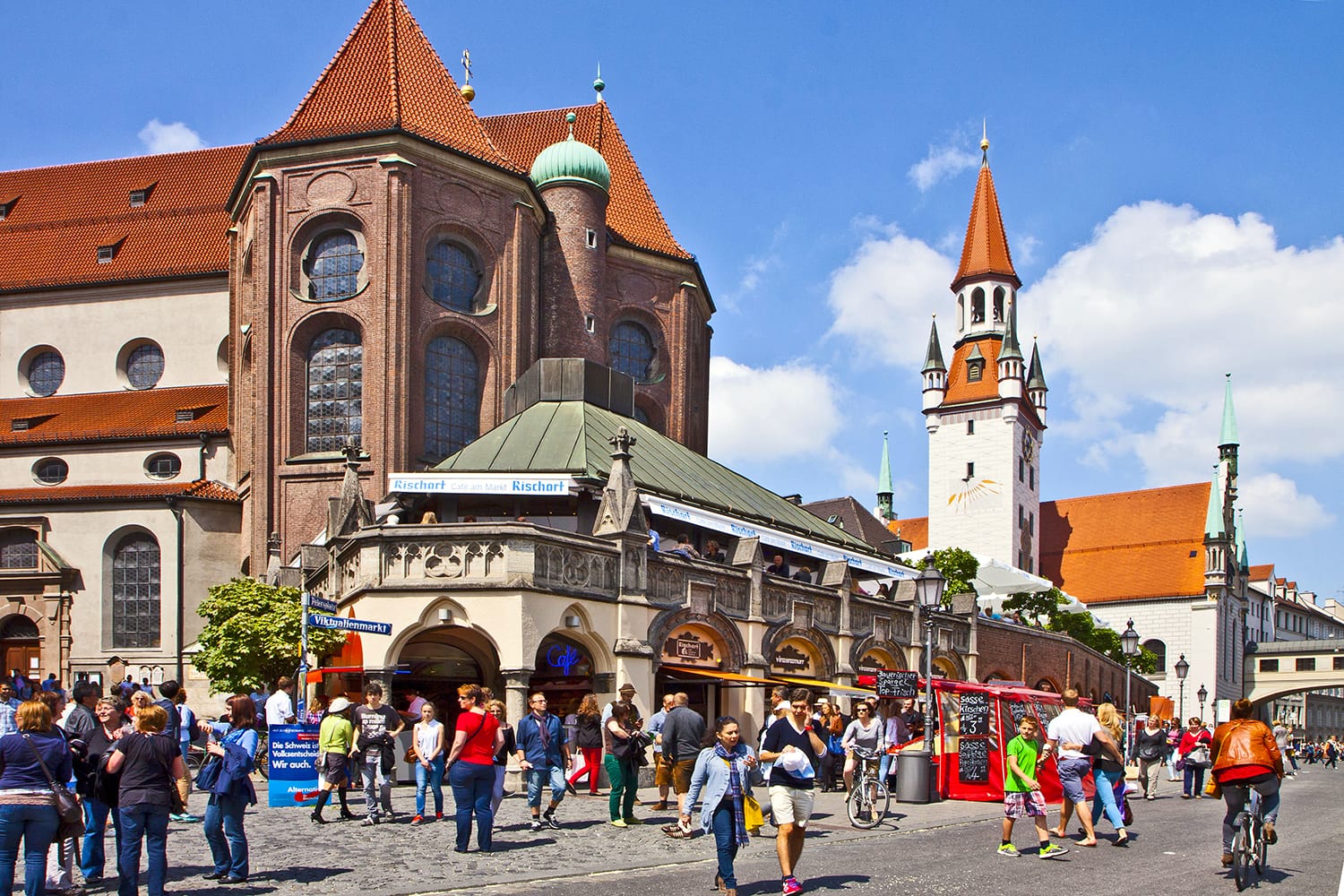
The Perfect 3-Day Munich Itinerary
With 72 hours in Munich, you have the opportunity to visit this wonderful city as either a special long weekend getaway or as a stop on a greater trip through Western Europe. Regardless of which option you choose, you’ll want a Munich itinerary. The guide should not only take you to the city’s most obvious attractions; it should also take you to different parts of the city and expose you to its many different sides.
And that’s exactly what this Munich travel itinerary does, showcasing the major attractions that lie in the heart of the city but also taking you across the Isar River and to outer neighborhoods. That way you get a comprehensive idea of what Munich is all about.
However, before we get to our Munich itinerary, we just wanted to remind you to purchase travel insurance. You never know what will happen and, trust us, you do not want to get stuck with thousands of dollars in medical bills. As a wise man once said, “If you can’t afford travel insurance, you can’t afford to travel.” So don’t leave home without it.
SafetyWing offers travel insurance for only about $10 a week, making it a no-brainer to get. You can get a quick, non-binding quote below:

SafetyWing is, of course, not the only option available. Two other popular alternatives are World Nomads and Heymondo.
Now that you’re covered should the worst happen, we can let you in on what to do in Munich in 3 days.
Day 1 in Munich
Start your visit of the best things to do in Munich visiting the many sights within the inner city. Many of these places are the most popular attractions in Munich and are not to be missed.
Marienplatz
There’s no sense starting anywhere but the main square of the city, Marienplatz. This square has always been the very epicenter of life in Munich, which is why you’ll find many of the city’s historical landmarks close by.
Marienplatz earns its name from the 11-meter-tall Marien column that takes pride of place in the square. Topped with a golden statue of the Virgin Mary, the column dates to 1638 and celebrates the Swedish forces leaving Munich during the 30 Years’ War. A lot of work clearly went into its design, including on the four little cherub warriors on each corner.
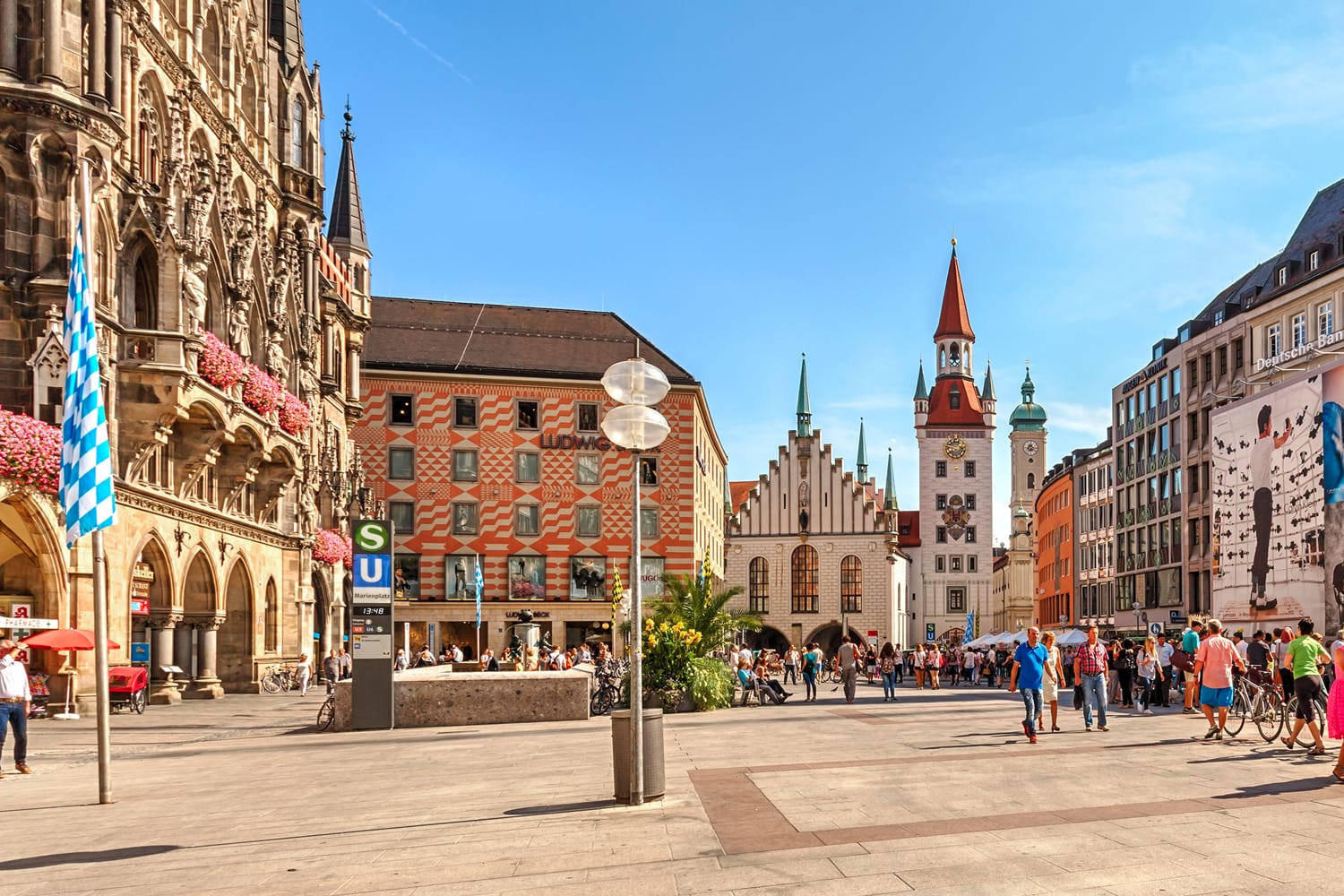
New Town Hall
While there are many interesting buildings that line Marienplatz, one that’s hard to miss is the New Town Hall of Munich. Thanks to its Gothic Revival architecture, this glamorous building has become one of the city’s most famous landmarks, despite being built in 1874.
Beyond its extravagant design, there are two elements of the New Town Hall that will interest tourists. One is the Town Hall’s glockenspiel, which features a little mechanical performance of dancers and jousting knights at 11 a.m. and 12 p.m., reenacting stories from the 16th century. The other is the New Town Hall’s tower, which visitors can ascend to enjoy fantastic city views.
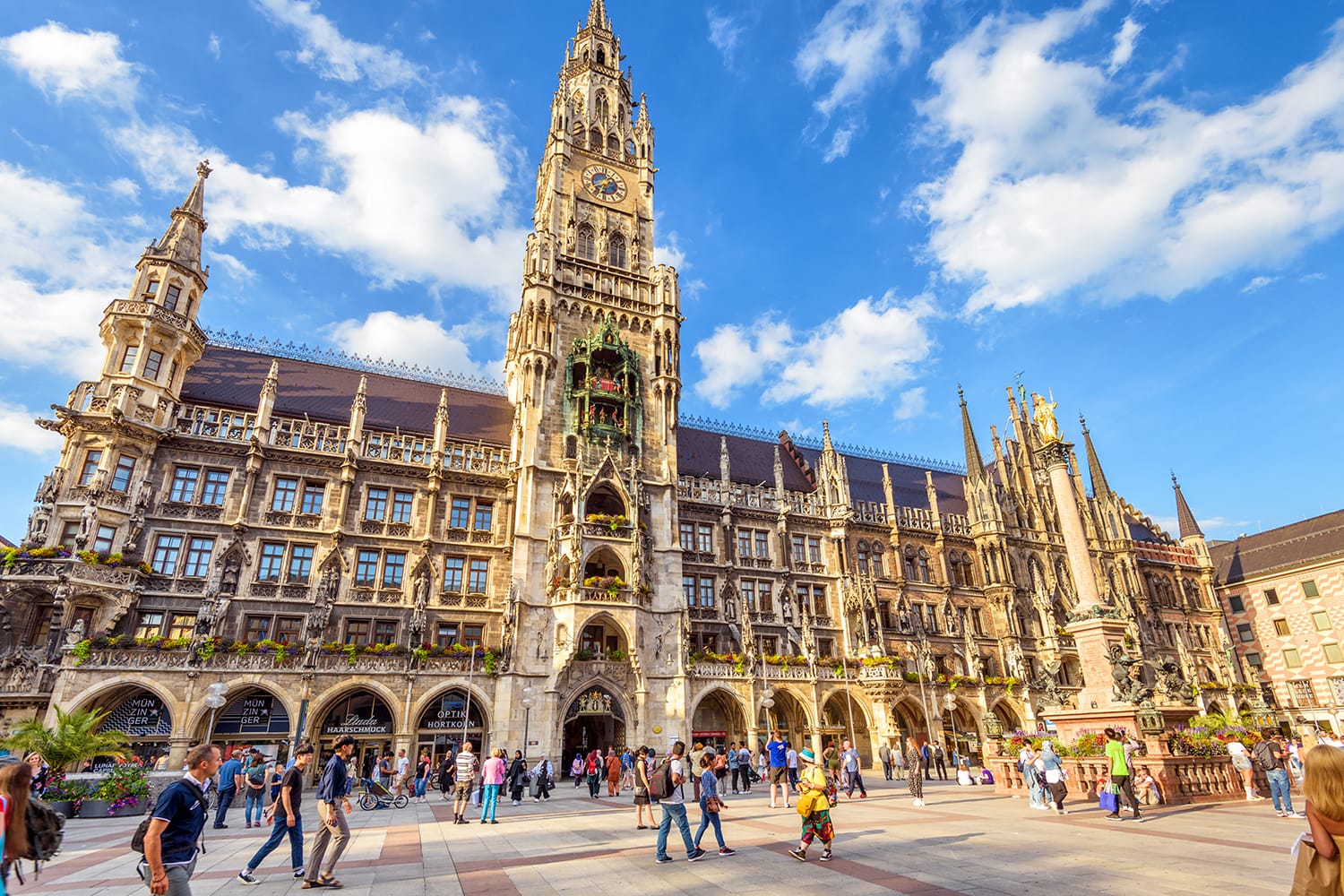
St. Peter’s Church
Just a block to the south of Marienplatz you’ll find St. Peter’s Church, the oldest church in Munich. Although severely damaged in World War II, it was faithfully restored and still features the mishmash of architectural styles applied to it over the centuries. So detailed was the reconstruction that even the cannonball that had been previously lodged in its brickwork from before the war was repositioned.
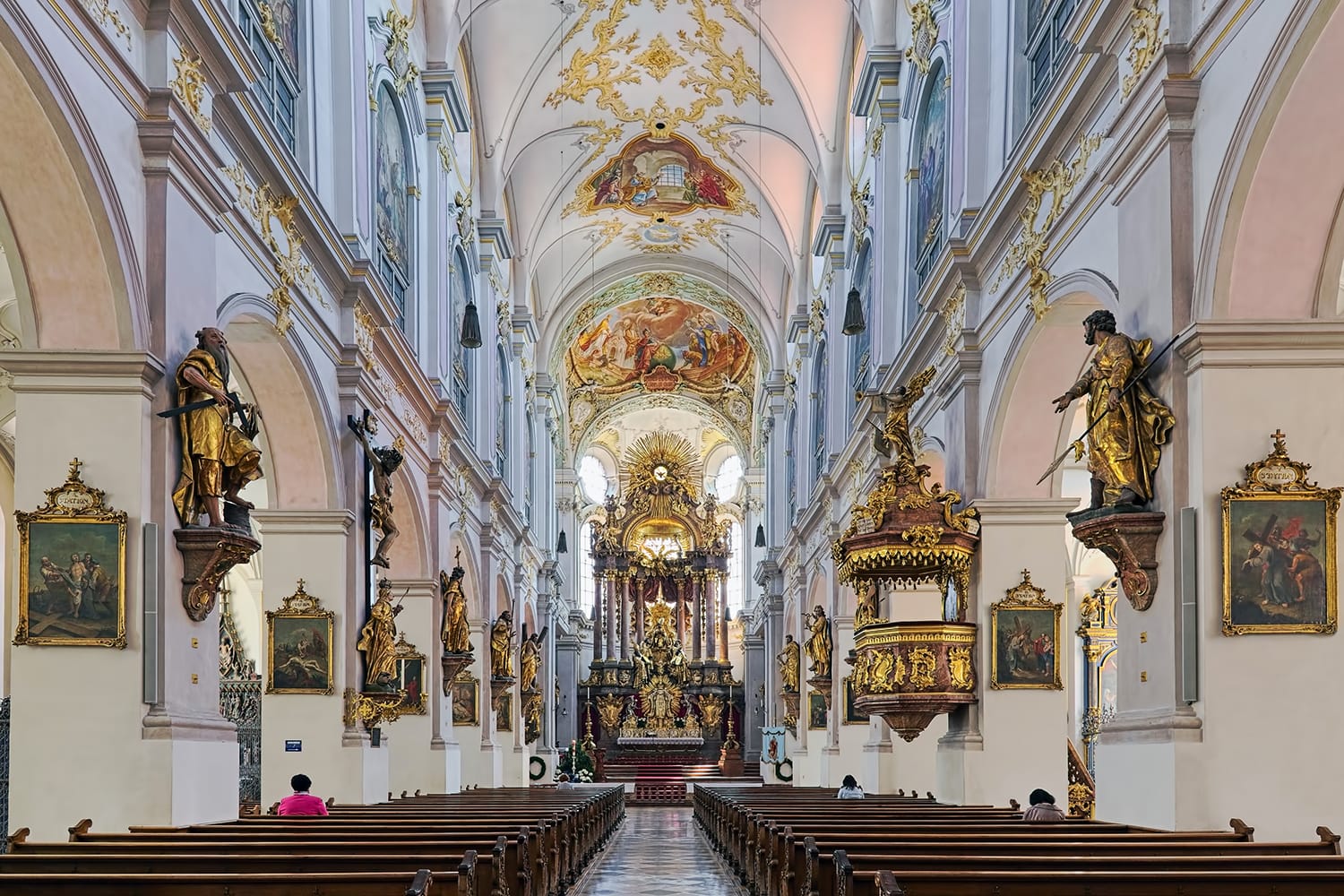
It’s also possible to head up the church tower for some superb city views. However, unlike the Town Hall and its elevator, here you have to take the stairs, all 299 of them.
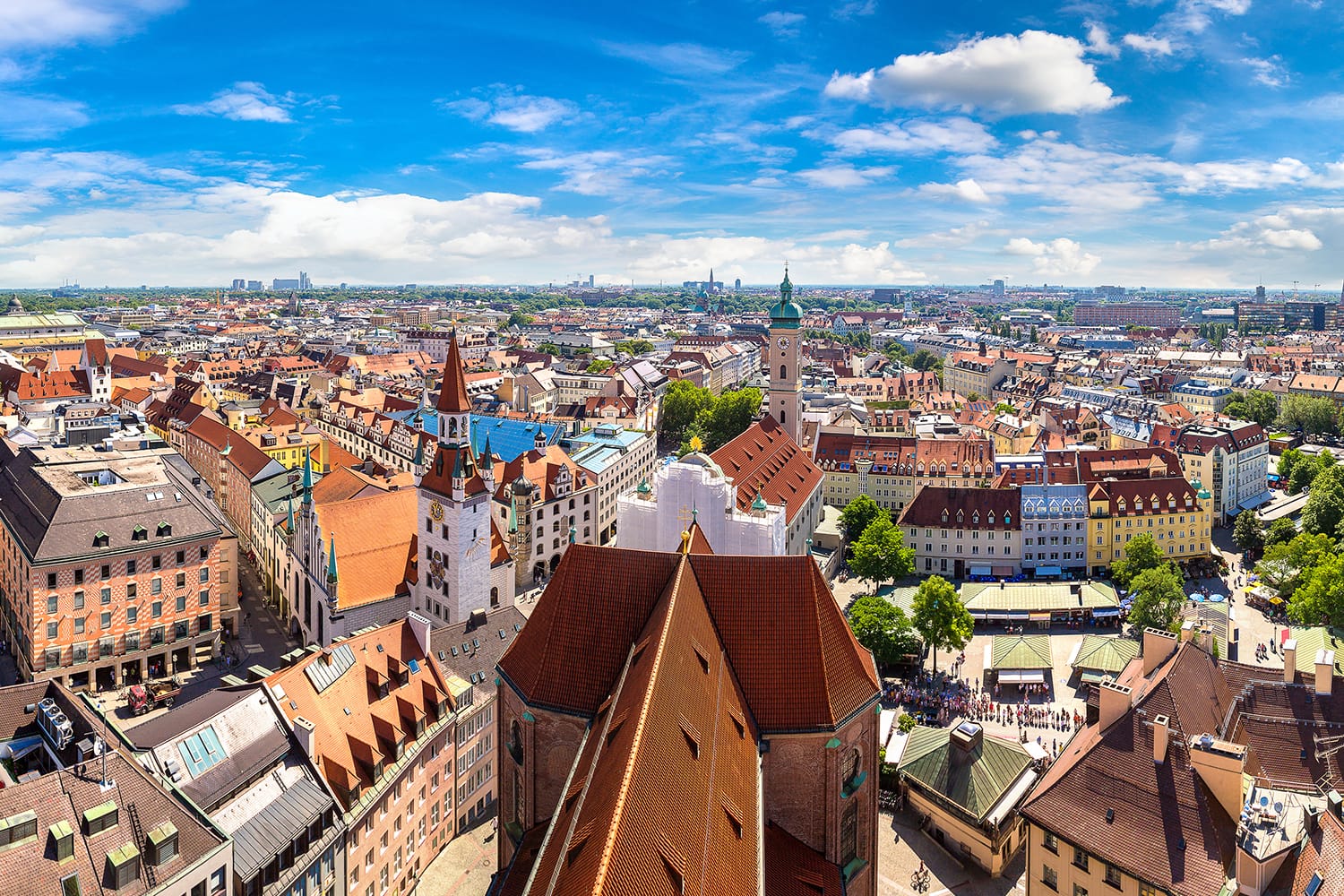
Viktualienmarkt
For a time, the main food market in Munich was at Marienplatz. Then it grew so large that it had to be relocated to the next square over, which is where you now find the Viktualienmarkt. It’s easy to understand why when you see how large the market is today, with 140 stalls selling all manner of produce. Everything from meat, vegetables, flowers, spices, cheese, and juice can be found for sale. There’s even a Biergarten in the middle of the market, not to mention food stalls where you can pick up local snacks like wurst and schnitzel.
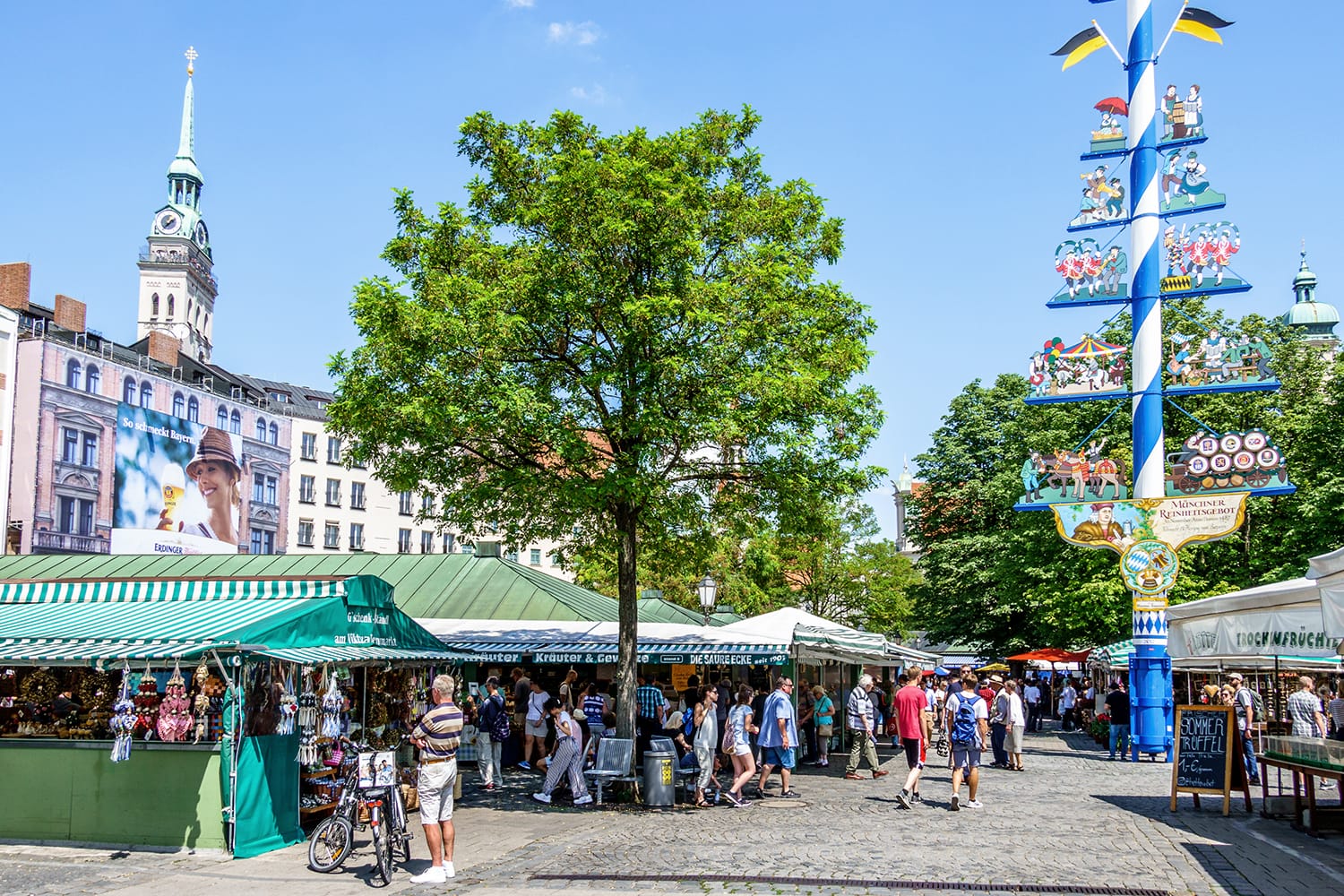
Munich Residenz
Walking through the city center, you’ll soon arrive at your next step, the Munich Residenz. This was once the royal residence of the House of Wittelsbach of Bavaria and had been in use since the 14th century. From the outside of the building you might be wondering what the big deal is, but just wait until you get a look inside.
The most famous room in this extensive palace complex is the Antiquarium within the Residenz Museum. Exquisitely decorated with frescoes and statues, this enchanting hall is worth a visit all on its own. You’ll also want to see the Ancestral Gallery, with its golden Baroque design as well as the spectacular Cuvilliés Theatre. Finally, there’s the Treasury, where the crown jewels of the Wittelsbach dynasty and other expensive treasures are on display.
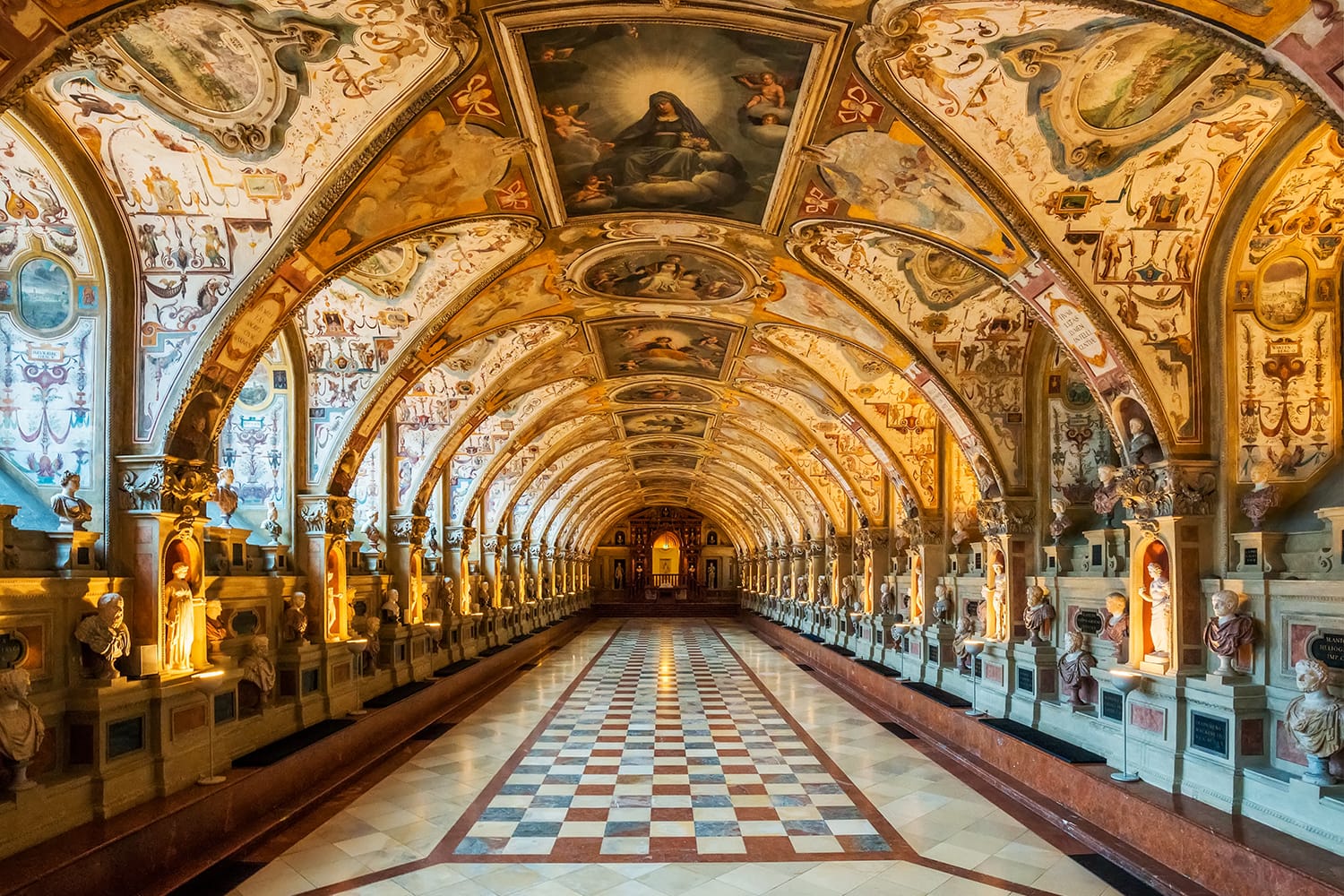
The Three Pinakotheke
Munich is no stranger to fine art, which is why the city has three world-class art galleries to show it off. Known as the Alte Pinakothek, the Neue Pinakothek, and the Pinakothek der Moderne, these art galleries showcase incredible works of art from different eras. Each can easily keep you occupied for half a day or more, so it’s best to start with the one that most interests you.
The Alte Pinakothek, one of the oldest art galleries in the world, is where you’ll find works from the years 1200 to 1800 by artists such as Leonardo da Vinci and Albrecht Dürer. Then there’s the Neue Pinakothek, which features art from the 19th century, including pieces by Degas, Cézanne, and Monet. The Pinakothek der Moderne features creations from the last 100 years and boasts works by Picasso, Kandinsky, and Warhol.
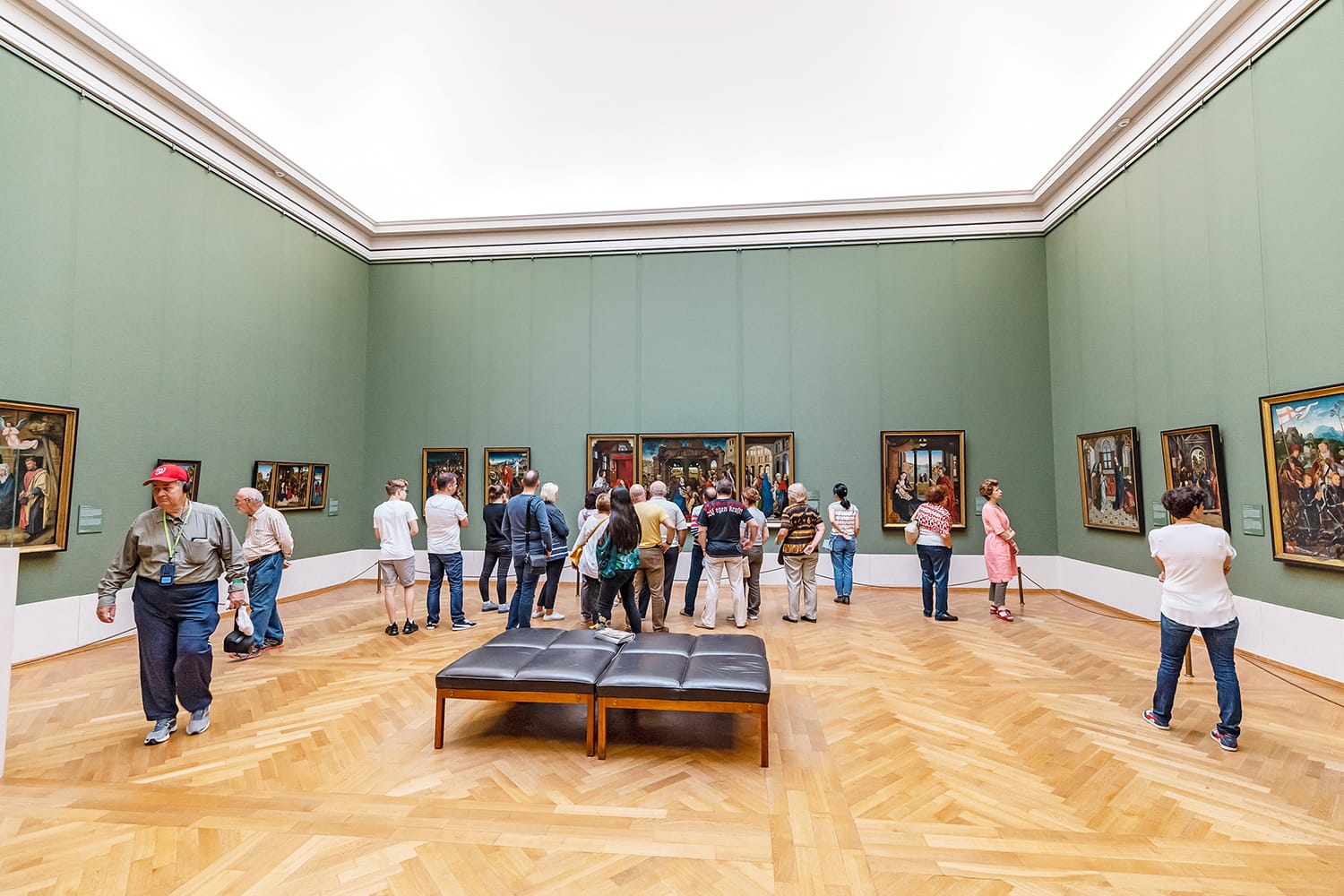
Hofbräuhaus
If there’s one attraction that nearly all visitors to Munich are going to see, it’s the Hofbräuhaus. This traditional Bavarian beer hall is famously tied to the city’s love of beer, as well as some darker chapters of its history. The hall dates back to the 16th century and was once part of the Staatliches Hofbräuhaus brewery. It is also the place where Hitler gave his first political speech.
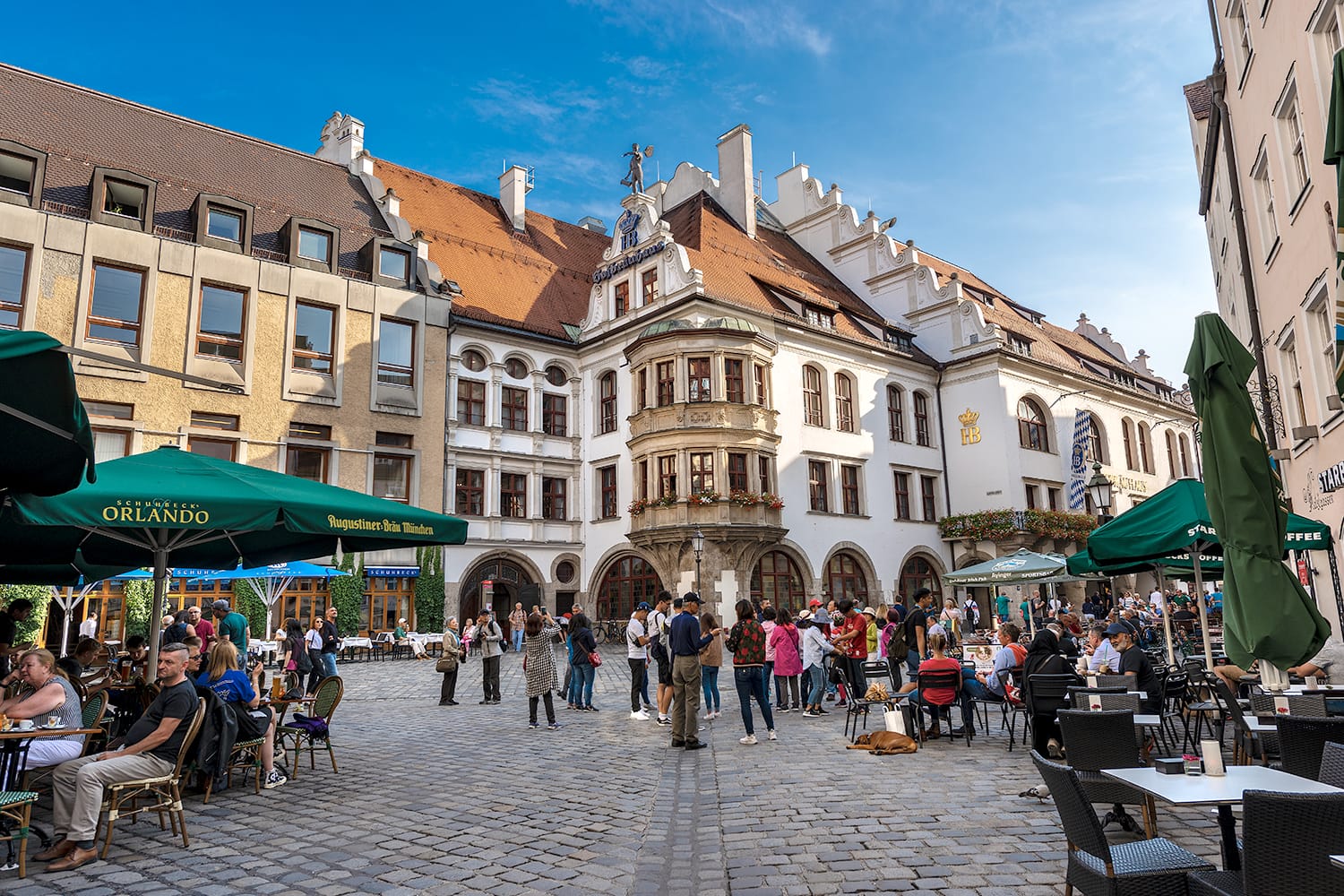
If you want to order a drink, you’ll first need to find a seat, which can be tough on the weekend and during high season. It may be quite touristy these days, but it’s still a nice way to get a relatively traditional beer-drinking experience in Munich if you can’t make it to Oktoberfest.
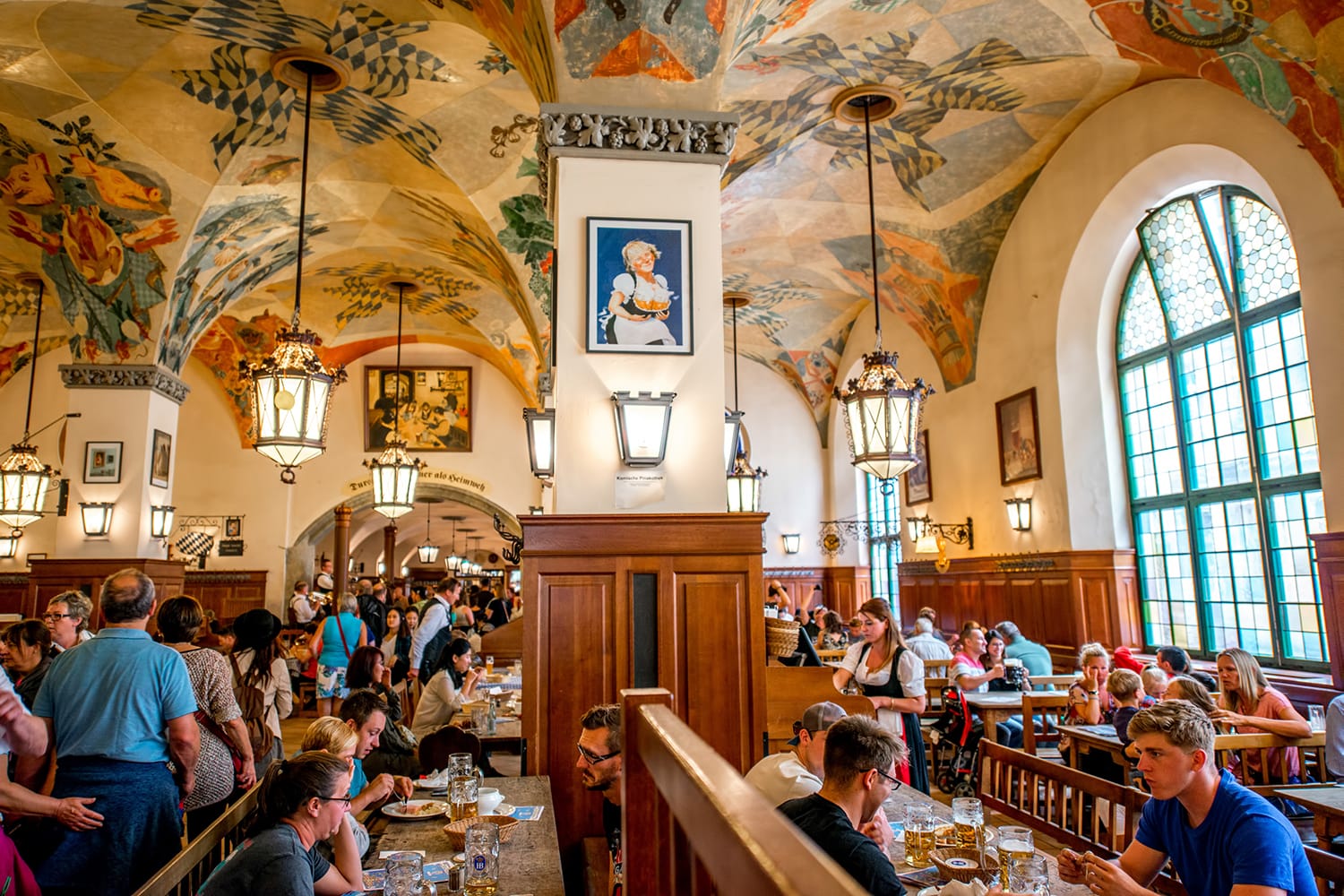
Day 2 in Munich
Today, you get the chance to explore beyond the inner city of Munich and really see just how much Munich has going on.
Nymphenburg Palace
First, head out of the city center and make your way to the Nymphenburg Palace in the western districts of Munich. This summer residence was built in the 17th century and expanded to its current splendor in the 18th century.
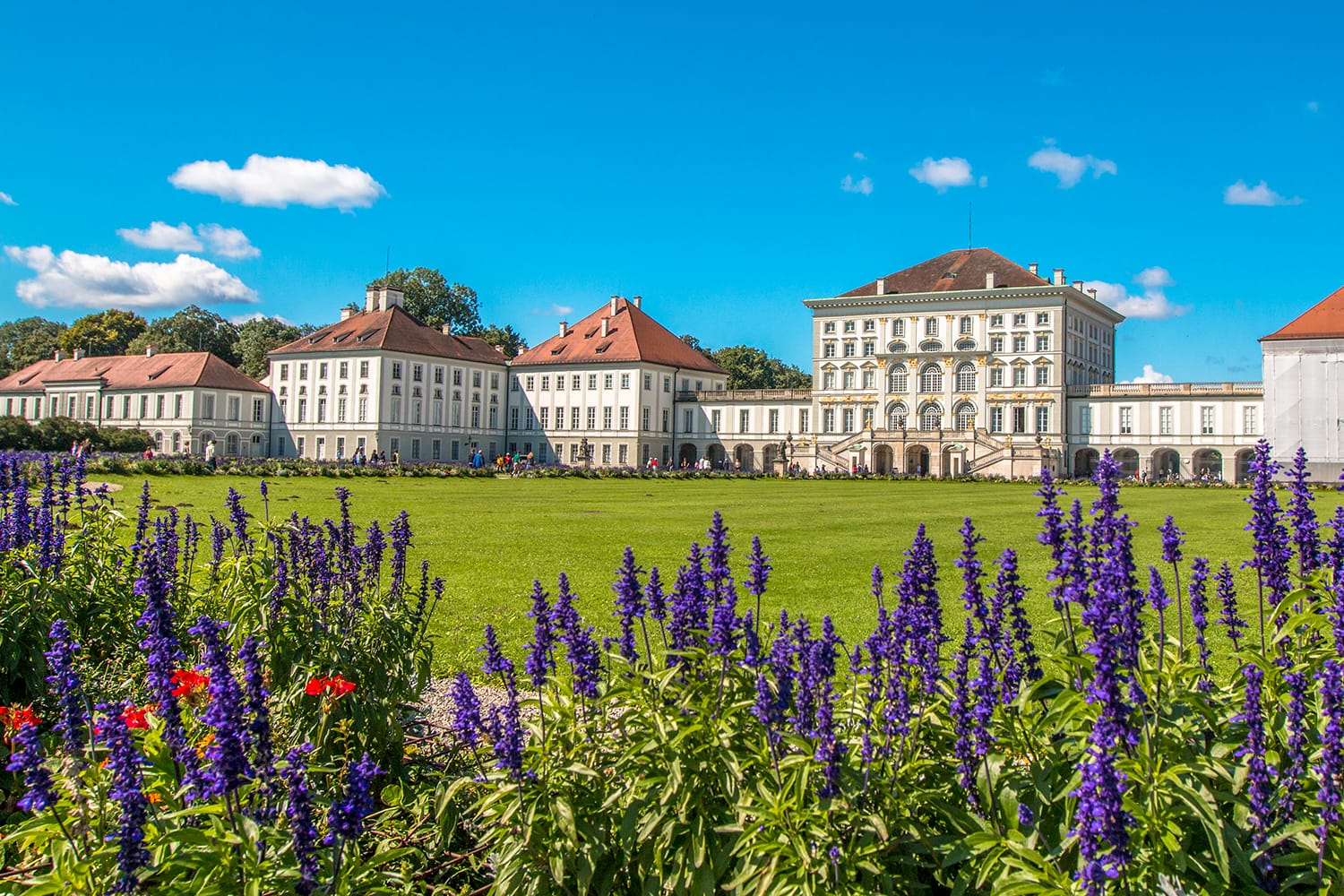
With a colossal 200 hectare estate around it, you could spend a solid chunk of your day simply wandering the palace grounds if you wanted to. Doing so would help you see not only the palace’s pools, fountains, and gardens but also the many ornate garden pavilions hidden among them. Of course, you can also take a tour inside the main palace building to see its halls and royal artifacts.
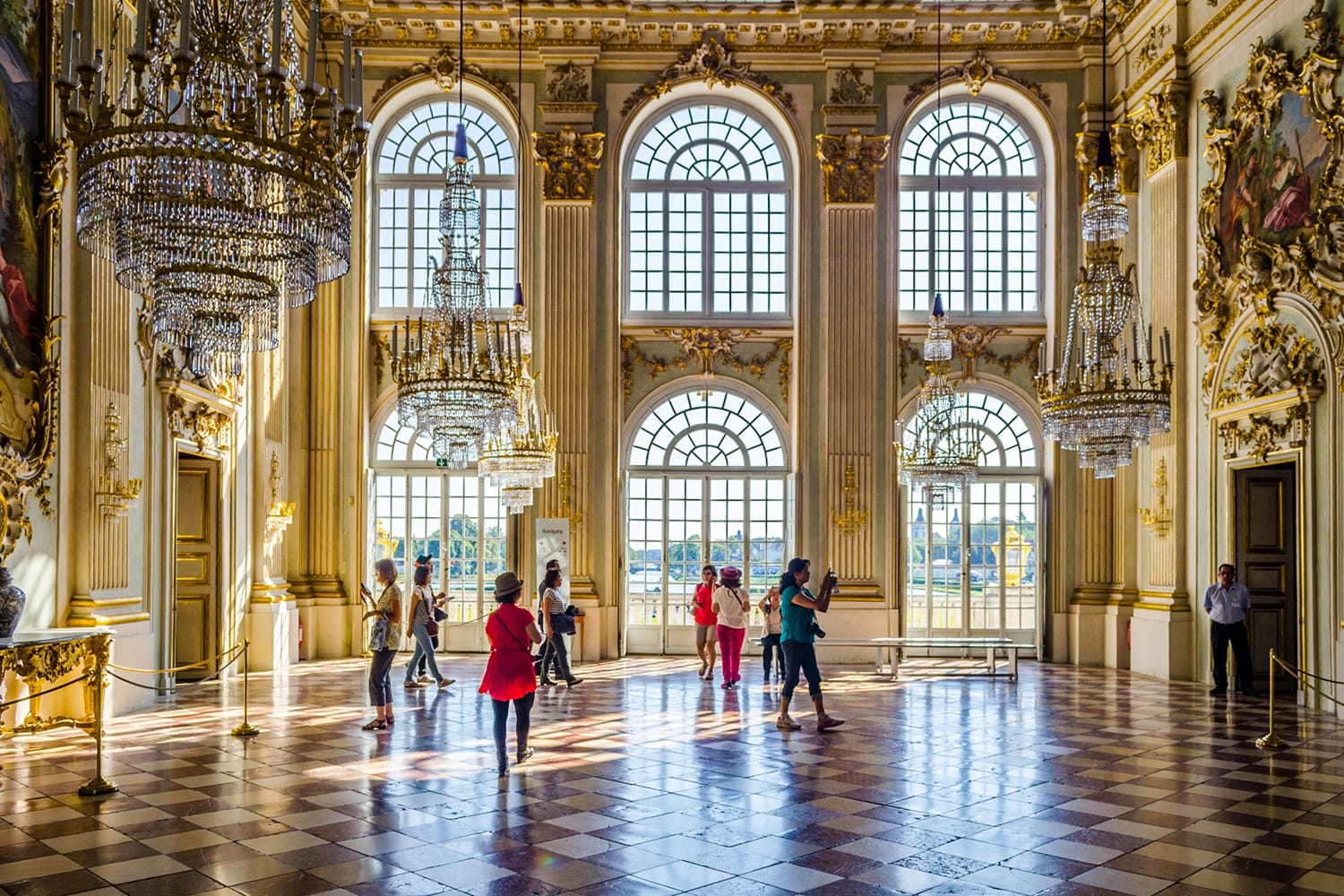
Lenbachhaus
Back towards the city center, you’ll find the Lenbachaus, another Munich art museum full of contemporary art. Here you’ll see works by Expressionist masters like Kandinsky but also quite a few pieces by local Munich artists. The building that the art museum is housed in is also quite interesting; part of it dates from the 1880s, while a striking modern wing was added in 2013.
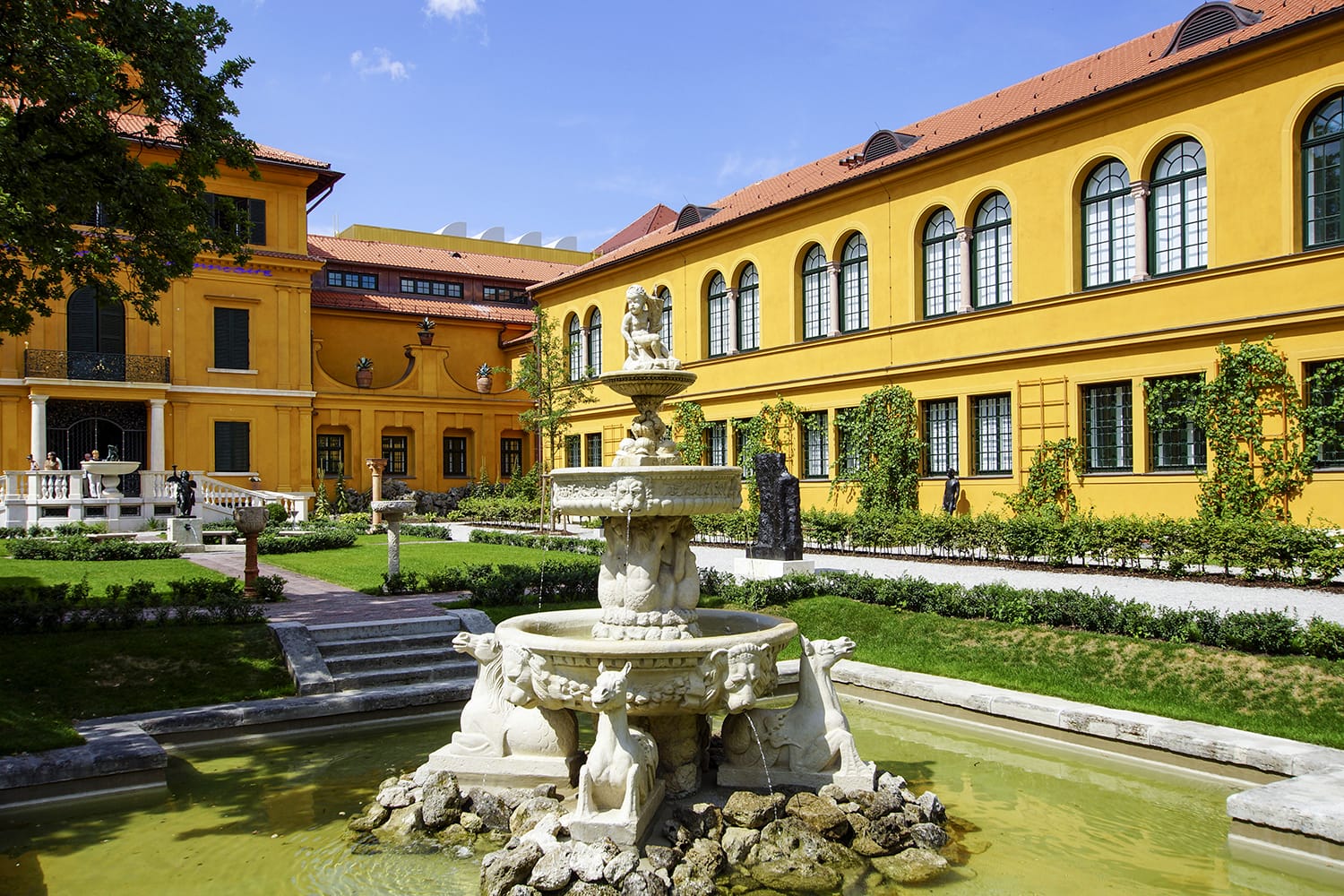
NS-Dokumentationzentrum
Next up is an exhibit on the role Munich played in the rise of the Nazi party and the events that led to World War II and the Holocaust. Known in German as the NS-Dokumentationszentrum, this square white building off Königsplatz is the Munich Documentation Center for the History of National Socialism. The exhibits go beyond artifacts from that time and instead focus on the antisemitism and racism that helped feed the rise of the Nazis. That the museum was built on top of the site of the former Nazi Party headquarters speaks volume about how the government wishes to address this particular piece of history.
Recommendation: If you want to learn more about the Third Reich and World War II, consider joining a Third Reich walking tour. On this walking tour, you will visit locations such as the Hofbräuhaus, where the Nazi party was first formed, and Führerbau, site of the Munich Agreement. You can book the Third Reich tour here.
Asamkirche
Stepping back into the Old Town for a moment, take a look at the Asam Church of Munich. The church earns its name from the brothers Asam, who designed the church in the 18th century. Take one look inside the church and you’ll see why they were granted that high honor.
As the church was originally meant as a private chapel, the brothers had artistic freedom, and the results speak for themselves. With lavish stuccowork, beautiful frescoes, and touches like twisted columns, the Asam Church is a visual overload in all the right ways.
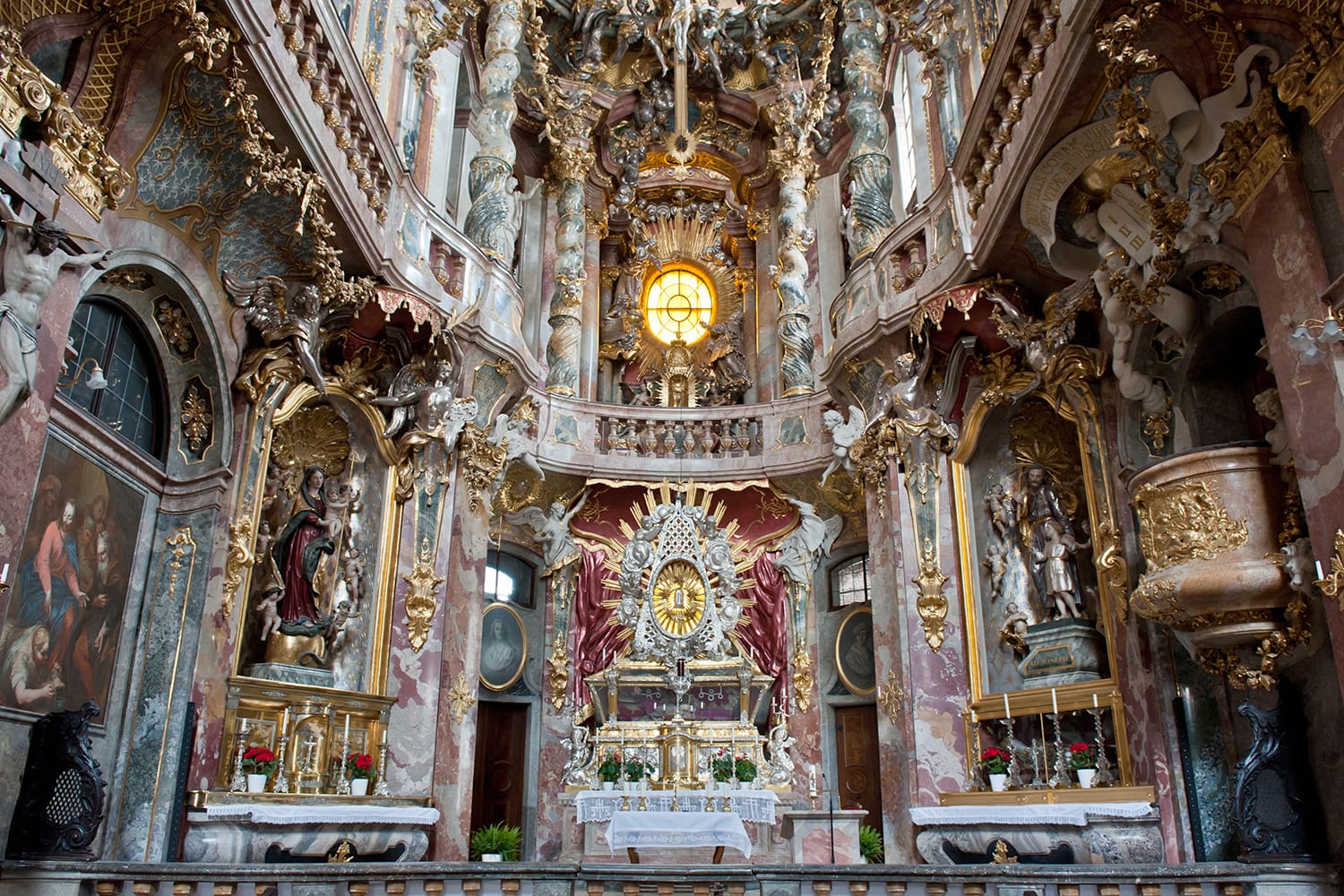
Deutsches Museum
Although the name of the Deutsches Museum might have you thinking it’s a museum on all things Germany, this is actually Munich’s fantastic museum of science and technology. Adults and kids who are scientifically or technically minded will find plenty here to entertain them, as exhibits cover a huge range of subjects, including nanotechnology and astronomy. Best of all, exhibits are designed to be interactive, ensuring kids won’t soon lose interest.
Bavarian National Museum
One last museum. The Bavarian National Museum is one of Munich’s most important as it handles art and artifacts that are tied to the history and folklore of the region. That means that inside this gargantuan museum, you’ll find everything from weapons and suits of armor to musical instruments and tableware. The building is quite grand all on its own and was actually purpose-built for the museum when it opened in 1855. No matter your interests, you’re bound to find something here.
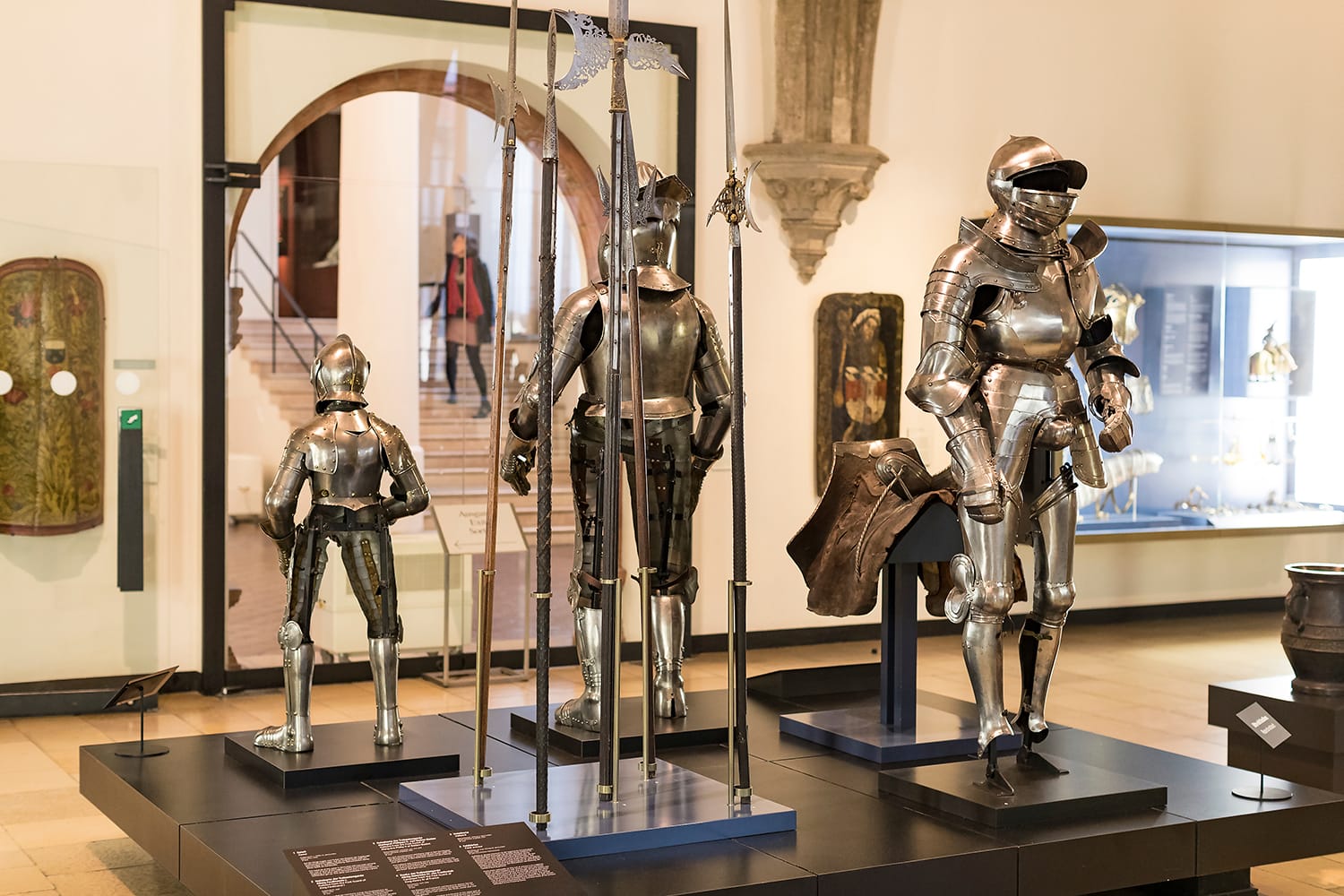
English Garden
Having spent so much of the day indoors, the best way to finish is with a walk through the city’s beloved English Garden. Covering 370 hectares within the city limits, it’s one of the largest urban public parks in the world. Besides ample green space to walk and unwind, there are a number of spots worth visiting. For starters there’s the man-made Eisbach River, where local surfers go to ride the static wave. Elsewhere, there’s a Japanese teahouse and the Chinese Tower, around which you’ll find a nice big beer garden.
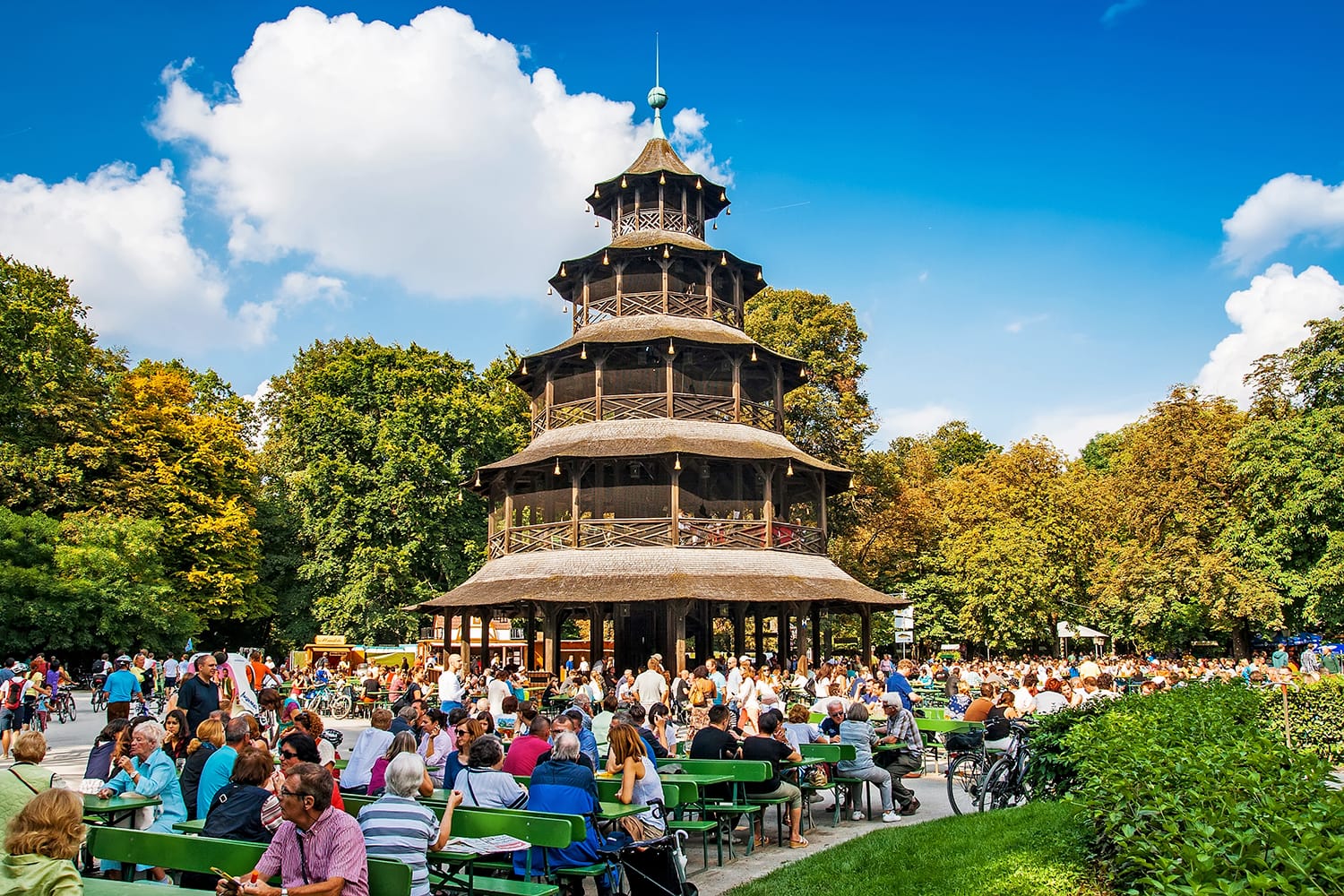
Day 3 in Munich
Having seen the best of Munich, it’s time to turn your attention to all the great destinations that surround the city. There are all sorts of great day trips possible from Munich, but to make planning easier here are three of the best.
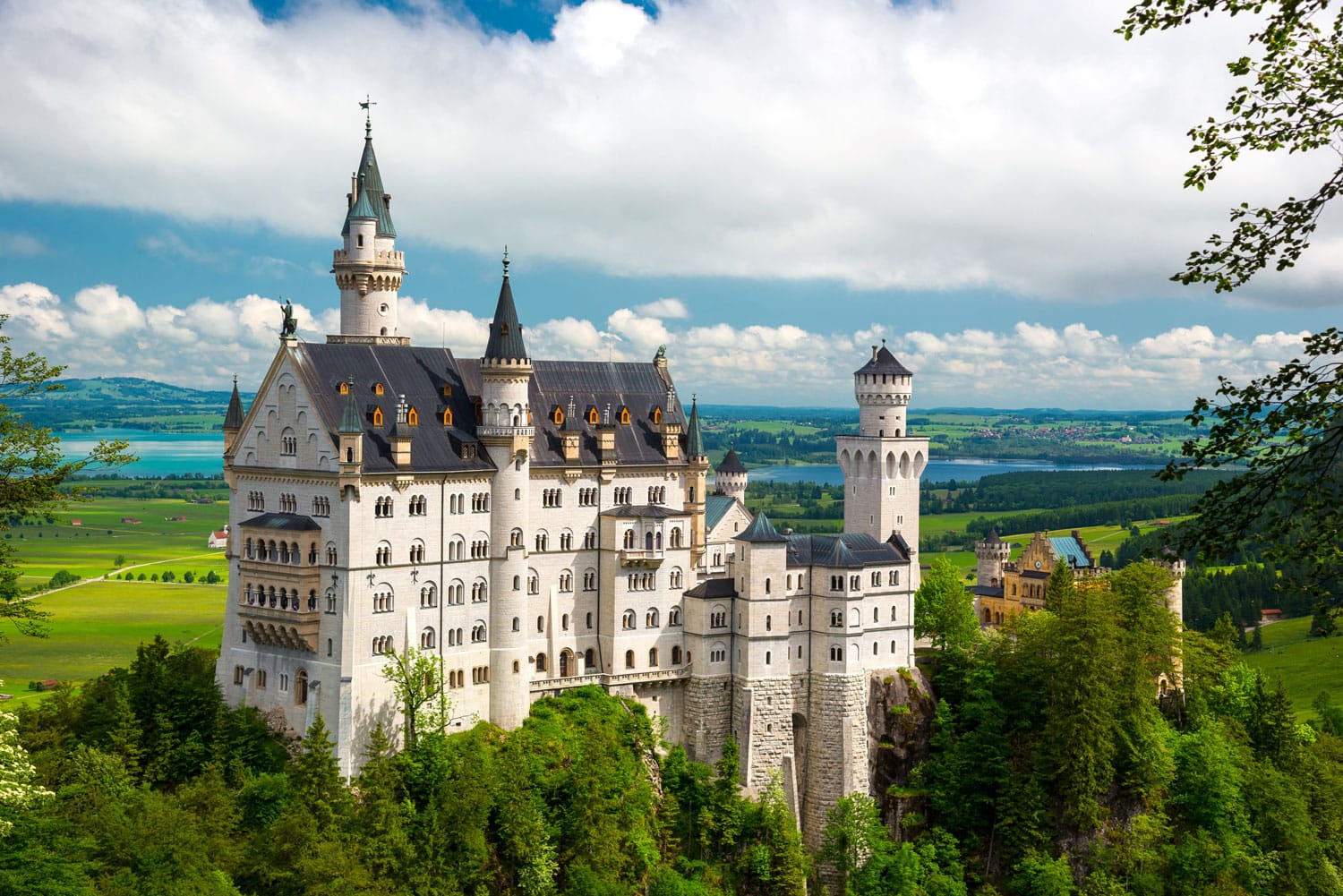
1. Neuschwanstein Castle
Germany is home to countless enchanting castles, but its most famous is Neuschwanstein Castle. This, after all, was the inspiration for Disneyworld’s Cinderella Castle. You can comfortably visit Neuschwanstein Castle as a day trip from Munich and still have plenty of time to bask in its beauty and learn the local lore.
Completed in 1886, the fairy-tale castle was built by King Ludwig II, who died before getting the chance to live there. It wasn’t long after his passing that the Romanesque Revival palace was opened to the public, eventually becoming one of Europe’s most popular tourist attractions.
Visitors are surely going to want to get a good view of the castle, with the Marienbrücke one of many great viewpoints for that. It’s also possible to take a tour of the castle, with 35-minute guided tours the only way to see the inside. On the tour, you’ll have the chance to admire the third and fourth floors of the castle, where you’ll see the Throne Hall, the Salon, and the Singers’ Hall.
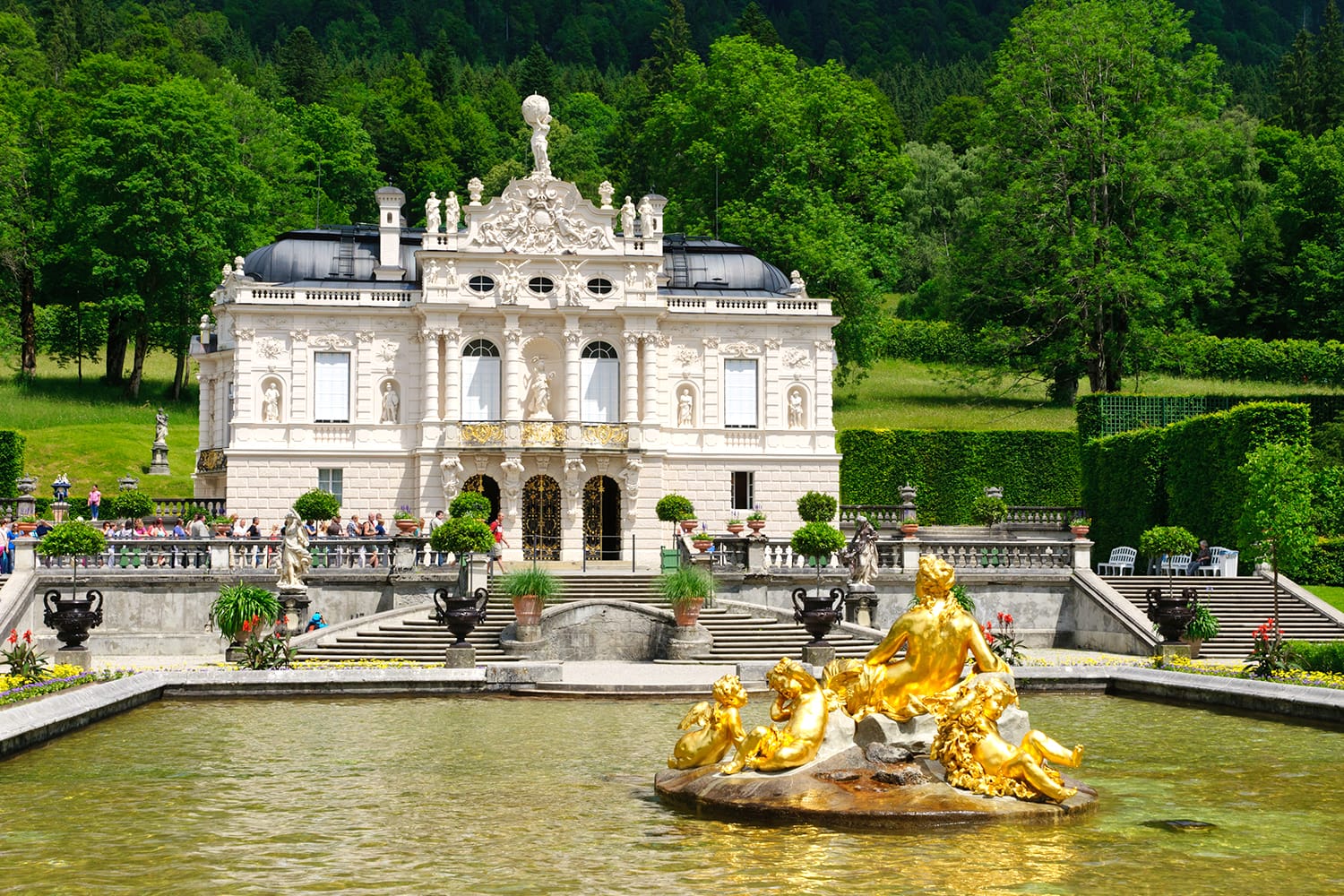
2. Linderhof Palace
Neuschwanstein Castle wasn’t the only residence built for King Ludwig II of Bavaria. The Linderhof Palace is another residence you can visit from Munich. Also known as the Royal Villa, construction of the palace finished in 1878 and Ludwig II was able to live there before he died. With its small palace and extensive royal gardens, the design takes inspiration from Versailles and other French summer palaces.
The centerpiece is the palace itself, with its elegant Baroque exterior and extravagant interior. Make sure to head inside to see the neo-Rococo interiors of rooms like the Dining Room, Hall of Mirrors, and Tapestry Chambers.
The palace actually replaced an old royal hunting cottage, and it’s easy to understand why Ludwig II liked this spot, with the surrounding moody forest and mountains. You’ll have plenty of time to appreciate the surroundings as you stroll by the large reflecting pool and out into the parkland that makes up the palace grounds.
Recommendation: Make the most out of your time and visit Neuschwanstein Castle and Linderhof Palace together in one day on a guided day tour. You can book the tour here.
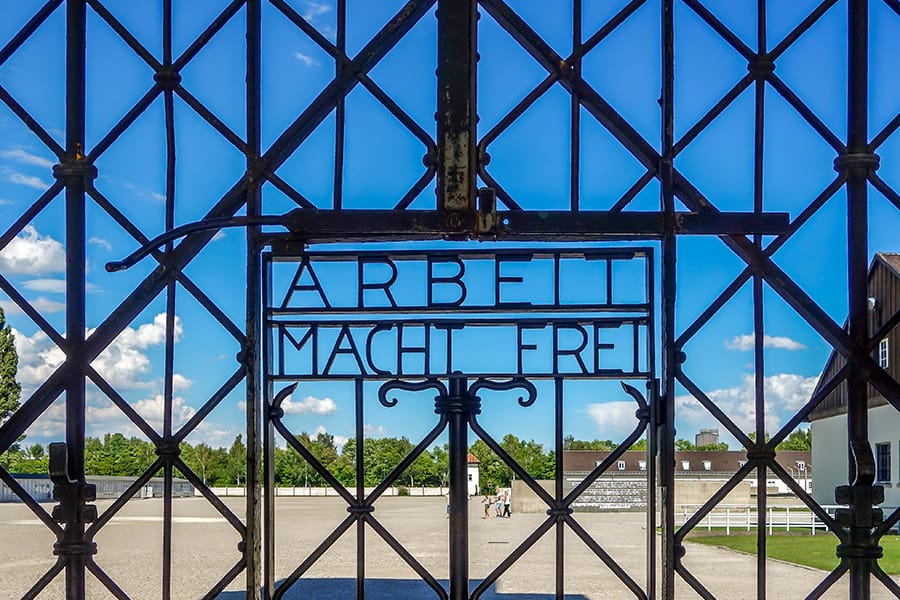
3. Dachau Memorial
Although nowhere near as enjoyable as the above two options, the Dachau Memorial is nevertheless well worth the day trip. This former concentration camp was actually the first created by the Nazis, in 1933, and was the setting for many horrific acts they perpetrated. Today, Dachau is a memorial to all those who were held prisoner and murdered there.
Visiting the Dachau Memorial, you’ll be presented with the camp’s history in great detail. You’ll learn how the camp was originally set up to hold political prisoners and how quickly murders began. All told, over 40,000 people were murdered in the concentration camp and more than 200,000 people imprisoned. The camp was finally liberated by American soldiers on April 29, 1945.
You’ll see many notorious places on a visit, starting with the Arbeit Macht Frei message on the front gate. As you go, you’ll pass by the barracks where prisoners lived and the gas chambers and crematoriums where prisoners were killed.
Recommendation: To really understand the history behind the Dachau Memorial site, it’s best you visit on a guided tour. On a tour, you’ll see the former gas chambers, barracks, and cells and learn more about the history of the Holocaust in Germany. You can book a guided tour from Munich here.
It’s clearly a lot, but you now have everything you need for a fun time exploring Munich in 3 days. With our Munich itinerary to help you, planning your trip should be a piece of cake.
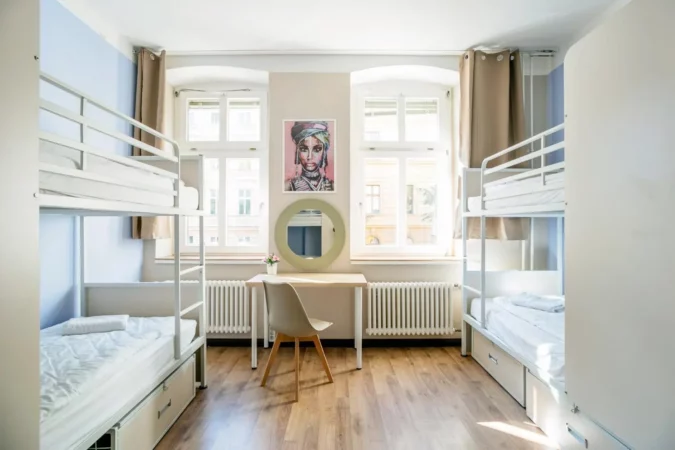


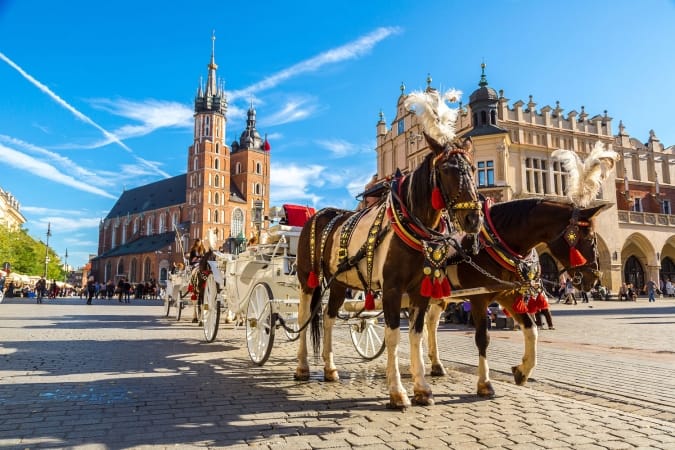
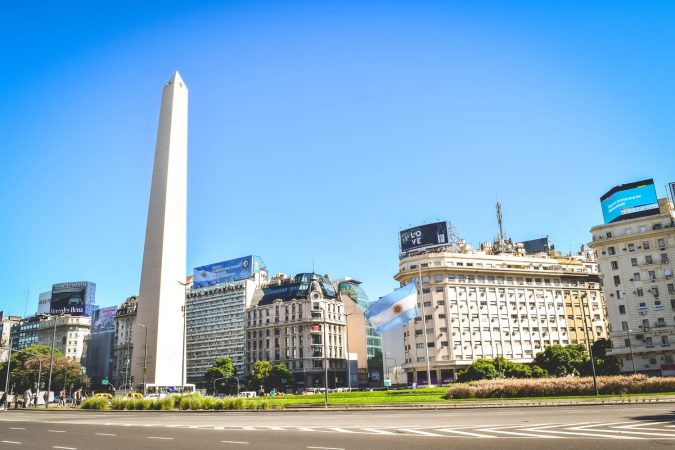


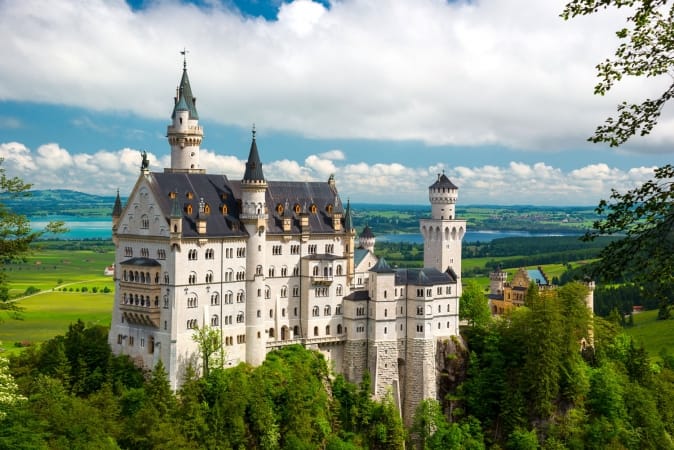
Michael Lies
Then after seeing all those sights in Munich. Drive to Ulm, home of the tallest church tower in the world. The town where Albert Einstein was born. Walk up those 600+ steps to the top. And if it’s a clear day you can see things 100 of miles away. Then drive south to Bad Reichenhall and soak in the salt water that’s pumped to the surface for the last couple hundred years. And then take the cable car to the top of the mountain to have a fine dinner. Then cross the border to see what’s left of Adolf’s Hitler’s house in Austria. Then walking thru Salzburg to see the sights and where they filmed the Sound of Music. A movie we all love to watch. My parents were from Germany. My mom was from Ulm and my dad was from Ludinghausen. That’s in the northwest side of Germany. My dad grew up in a very large home and he had a castle in his back yard. Burg Vishering. And I went to cooking school in Bad Reichenhall. Every town big and small has there sights. Every town haas there hiking trails and alot of them have there castles. I would love to go back, but my health is keeping me in FL. But my memory’s in my head keep those beautiful sights there. Yes it’s a beautiful area, but it is very expensive. Now travelling there is very hard with the high fuel costs. And they use the metric system. 2 liters is almost gallon of gas. And there prices are much higher then our prices.